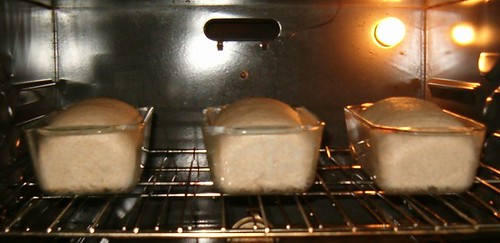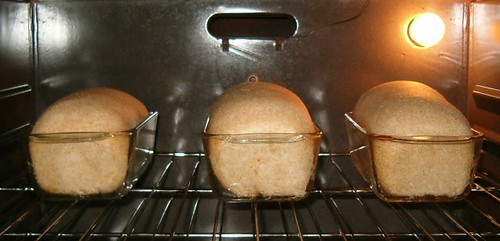I have a recipe for sourdough bread where the bread starts baking in a cold oven. After the various rising and resting the recipe states "place the pan with the loaf in your oven, then turn your oven to 350 and bake for 30-45 minutes. Do not preheat the oven" Has anyone else heard of this? Does it sound right? Should I give it a try?
About baking bread starting with a cold oven, but I must admit I have never tried it myself. You might want to search around a little on the forums for advice about starting your loaf in a non-preheated oven? Good luck with it, anyhow!
I did this recently using a cast iron pot. I found the crust to be light and shattery--very bakery-like. I prefer a more substantial crust however. Still, I think it would be great for dinner rolls--I think next time I do rolls in my cast iron skillet I'll use a cold oven.
I have an old double oven so this weekend I think I'll do one sourdough loaf in the preheated and one in the cold. I'll post the comparison photos.
...inquiring minds plus the idly curious are eager to know. I place myself in the [i]inquiring minds[/i] category and will be very interested in your test, as I would like to explore this method. Any info you care to give would be greatly appreciated.
I'm especially interested in your comment...
as I would like to achieve a thinner crust baking in a closed cast iron container.
thanks in advance - SF
I wanted to see what difference it would make to bake loaves from the same dough, one in a preheated oven and one starting off in a cold oven. In a previous post I mentioned that I had tried the cold oven technique using a cast iron pot. The resulting bread had a very light, shattery-type crust. It was an unusual loaf for me, but then again, the circumstances were not usual. We were at our cabin and I had no scale, no mixer, no sourdough.
Back home, I took advantage of my 1960 double oven to put the hot v. cold oven to the test. Because one oven is smaller, I used an oval Le Crueset for the loaf I started in a cold oven and a round Le Crueset for the loaf I started in an hour-preheated 500 degree oven (the pot was preheated too). I baked both until 205 degrees internal.
A cold oven is supposed to produce a good oven spring but that didn't happen here. The cold oven loaf collapsed where scored. I've never had a loaf collapse on me before so I suspect it was the cold oven. I don't think it was because of overproofing. After shaping, I only proofed it 35 minutes because I'd heard it was best to underproof if using a cold oven.
As you can tell, the crumb is very open. The bottom crust is burnt.
The round loaf came out looking better. Decent oven spring. The crumb was more regular (not necessarily a plus) than the oval loaf--but that may be because of the shaping process.
The next mystery I need to resolve is how I got that shattery/light crust in the loaf I made at the cabin. Any thoughts??
And now, I better clean the oven!
your identical post at http://www.thefreshloaf.com/node/16588/side-side-comparison-loaves-baked-cold-start-v-preheated-oven-photos
the link is for my questions is http://www.thefreshloaf.com/node/16588/side-side-comparison-loaves-baked-cold-start-v-preheated-oven-photos#comment-107335
Sorry about my double post, but I'm very interested in your feedback.
Thanks - SF
I do this all the time. The point in doing this is to save the energy of heating a stone for a full or more before baking. If you bake on a sheet pan using parchment baking paper, you can skip the pre heat. I do cheat by waiting until I think the proof is just about done and then turn the oven on. When the up to temp beeper goes of, in goes the dough. So it's not cold completely but I'm not wasting much energy and the bottom crust is fine.
Eric
I just got a recipe for a no-knead sourdough that says to bake at 450 covered in a cast iron pot for 70 minutes. No peeking, no pre-heating oven or pot. Also, use the pot for the last rise.This will be my next experiment.
I don't understand your method, ehanner. You say you put the dough in when the temp beeper goes of [sic]. Isn't that a pre-heated oven?
Or do you mean you have stones in the oven, and your oven is up to temp but the stones are not?
that the post you are responding to is from 2010! And to answer your question, I think he uses just a sheet pan to bake on, no stones involved. And yes, it is a preheated oven.
Once you put something on the internet, it sticks around for a long time. And the same issues come up time and again with every new crop of newbs like me.
The beeper he mentions is the oven's signal that it has reached the selected temperature, therefore preheated. Some people choose to start with a cold oven when a stone is not employed, which saves energy. Even a regular preheat, which Eric apparently did, uses less energy than bringing a stone to full temperature. That could take as much as an hour for a very thick stone.
Paul
As best I could tell, he was leaving the stone in the oven, and calling it pre-heated when the oven came up to temp, but before the stone did. I don't know why someone wouldn't just take the stone out though.
I always bake my round loaves in a cast iron casserole from a cold start, after about 45-50 mins they are always perfect, I just take the lid off for the last 5mins to brown. Give it a go in a pot!
Cheers, Steve
How do you set the temperature? Do you use it for both yeasted and pure sourdough breads?
Could I also ask for recommandation - how big (diameter, depth) should be a pot to handle at least 500g flour dough?
Thanks for help!
zdenka
I use my inexpensive Lodge 5 Qt. Works great
Paul
Do you grease the bottom of your cast iron casserole?
Parchment paper cut in wide strips, then placed across each other in the dutch oven works great and gives you "handles" to remove the bread.
That if your oven normally takes a long time to preheat (over 30 minutes without a stone) then it might be wise to bring it up halfway before loading it. Or Completely cover the loaf and use convection which is faster in heating up the oven. It all comes down to knowing your oven and proofed loaf.
If your loaf is fully proofed, it will overproof in a cold oven so it should be placed in the oven before it reached double or was fully proofed, 15 to 30 minutes earlier.
Nice to see this topic surface again.
A reminder to those who have a baking stone - remove it from the oven if you're doing a cold start.
Like Renee72 (and others), I find this works best for bread baked in a container (loaf pan / cast iron pot). Despite Ehanner's advice, I can't get it to work for a freeform loaf (and I've tried many times).
It works well for bread baked in loaf pans, as you can see...
[b][u]Cold Oven Baking: Fifty Percent Whole Wheat Loaves at Beginning of Baking[/u][/b]
[b][u]Cold Oven Baking: Fifty Percent Whole Wheat Loaves 20 Minutes Into Baking Cycle[/u][/b]
The photos are from this TFL post [url]http://www.thefreshloaf.com/node/4697/should-i-steam-cold-start-sandwich-loaf[/url] (scroll down). At the time, I'd not used a cold start for sourdough loaves (baked in a loaf pan), but have done so subsequently with success.
Its nice to learn that this approach also works for loaves baked in a covered cast iron pot. I'd love to see some photos from folks who have done this successfully. (My 5-quart cast iron dutch oven is a little large for the smaller loaves my family prefers, so I don't use it that much.)
I'm not convinced this actually saves much on fuel but it [i]is[/i] more convenient.
I bake sourdough sandwich breads all the time and I never pre-heat the oven. I let the dough finaly proof in the oven with a pan of hot water. It usually takes 2 hours to double or even triple. When the loaves are big enough I take out the pan of water, turn on the oven to 350F and bake for 50 minutes. My oven takes 10 minutes to heat up to 350F and that's when oven spring takes place. It seems to me that the moist heat left from the hot water improves the oven spring and creates a nice crust. My husband and our son love their sandwich bread that way.
An old picture of my SD whole wheat sesame, SD black, and SD garlic loaf.
Al
VERY happy! ?
I live in a semi-tropical country and they find the idea of piped-in gas a hoot!
Stoves don't always have ovens, and even those that do rarely get used to bake because of the cost of a tank of propane. It needs to last a whole month and US$7 is a lot for the average family's budget.
I'm going to try the cold oven method for my next bread. Maybe I won't get the beady eye from my housekeeper.
After years of preheating the oven and Dutch Oven to 450 F for an hour or so, I've made my last 4 loaves starting cold. Mix, autolyse, salt, slap & fold every 30 minutes for 2 hours, then into the fridge for 18 hours. Next morning shape, banneton for an hour and onto parchment, slash, heavy spritz of water & cold oven for 50 minutes. The cover stays on for the full 50 min. Internal temp. around 200 - 206. My loaves are large 660 g AP which includes 100 g mix of WW and rye at roughly 73% hydration. Best loaves I've ever made. Recipe in full on request.
Good baking all and thanks for this site, so much to continue learning.
Should have added that I bake the loaves at 425F for those 50 minutes... minor detail right?
and recipe please!
Good baking to you!
However, no pictures! Did you forget to attach them?
I have old technology, Nikon D80, I refuse to have a cell phone though for a fast picture it would come in handy.
It works for me every time. 230C for 55 min covered and another 8 to 15 mins uncovered depending how crusty you prefer.